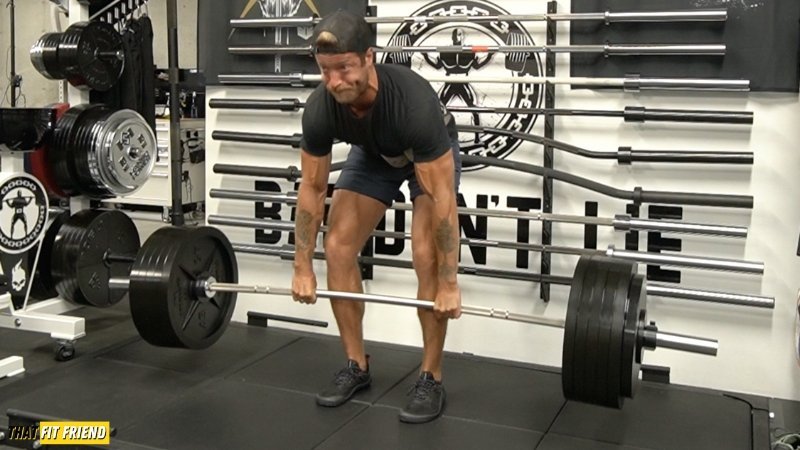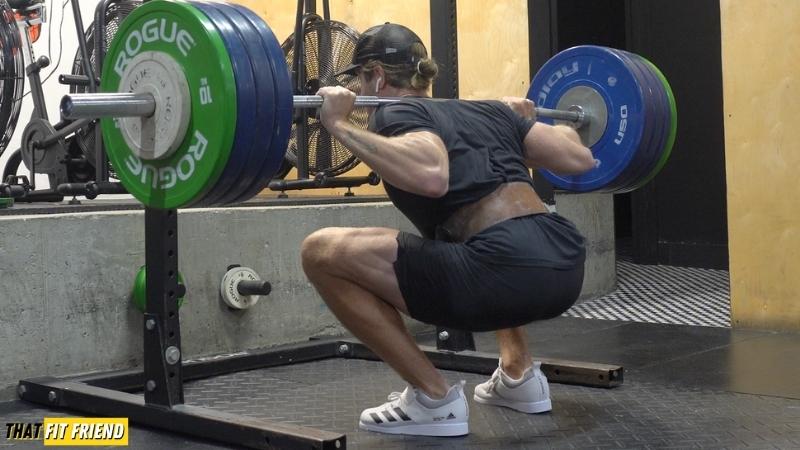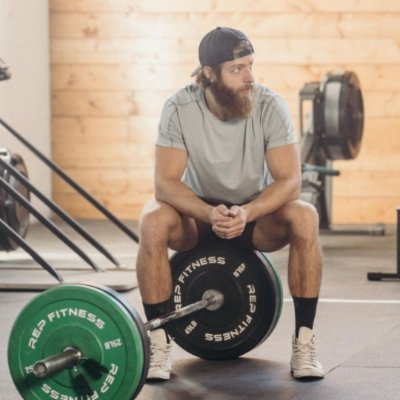The squat and deadlift are both pinnacle movements in nearly every exercise program. Whether you’re performing barbell back squats and deadlifts or variants of them there’s a good chance you’re squatting and deadlifting every week.
When comparing the squat versus the deadlift I’m often asked by clients about the muscles they work and how each compares to one another. I’m also frequently asked if squats can increase deadlifts, and vice versa.
In this article, I’ll cover the squat versus the deadlift in a variety of contexts and applications and hopefully help you synthesize when you should use each to accomplish your goals.
The squat will typically create more carryover to deadlift strength than the other way around. This is likely due to the squat training the legs through deeper ranges of motion while also passively building the back from a stability context.
Coach’s Note: As you read through this article I tried to break it into sections that cover the squat versus deadlift from beginner, intermediate, and advanced contexts.
Squat Vs Deadlift Differences
When comparing the squat to the deadlift I think there are three main differences to keep in mind. These differences can help you decide when you should use and program each exercise depending on your goals.
Difference 1: The Range of Motion You’re Moving Through
The first major difference to note between the squat versus the deadlift is the ranges of motion you’ll be working through with each exercise. These ranges of motion will vary greatly at different joints.
For example, the squat is going to take you through a greater range of motion overall compared to the deadlift, especially in the context of the knees, hips, and ankles.
When squatting to depth, you’ll be working through greater degrees of knee flexion, hip flexion, and ankle flexion, whereas in the deadlift, your range of motion will be more hip flexion dominant and you’ll work through less ankle and knee flexion overall.
Both exercises will have similar degrees of range of motion they’ll take your torso through and your squat and deadlift mechanics can influence the flexion and extension your torso moves through.
For example, if you’re a low-bar squatter then your torso will move through greater ranges of motion compared to a high-bar squatter, and this is similar for deadlifters that are more knee and hip-dominant with their mechanics.
All that said, you’ll typically more through greater ranges of motion with the squat compared to the deadlift, and this can influence the muscles you’re training which I’ll cover below along with the fatigue you experience when volume is equal.
Difference 2: The Muscles You’ll Be Training
While there will be some carryover between the muscles that the squat versus the deadlift trains, you’ll generally program and perform each of these exercises for different reasons when muscle building is your goal.
The squat primarily trains the quads, glutes, and adductors, and you’ll be passively training muscles like calves, torso stabilizers, and hamstrings, as they all assist with squat mechanics.
Since you’re moving through greater degrees of hip and knee flexion that’s why you’ll have a greater quad, glute, and adductor bias with the squat and you’ll typically program them when you’re trying to build the legs as a whole.
The deadlift will primarily train the glutes, hamstrings, and back muscles like the erectors, lats, and upper back. You’ll also be passively training the quads, calves, and torso stabilizers with the deadlift.
Since the deadlift is a more hinge-style exercise, you’ll be putting a lot of stress on the glutes and hamstrings as you lengthen them during the start of your deadlift. The back muscles will also play a role in keeping the back close to the body as you lift.
For muscle development, you’ll usually program the deadlift when your goal is building the posterior muscles. That said, the deadlift will definitely train muscles like the quads.
However, it’s not necessarily the best exercise for doing so, so most won’t program them for this, but don’t sell the deadlift short in the context of utilizing the quads!
Difference 3: The Fatigue Each Exercise Can Accumulate
The concept of fatigue that follows the use of squats and deadlifts is interesting and it’s a lot more individual than many make it out to be. For example, some research states that deadlifts are more fatiguing while others suggest squats as being more so.
From both my coaching and personal experience, it really depends on the individual and a multitude of factors. Plus, we have to consider that there’s always a spectrum of muscular and neural fatigue that exists for most lifters.
In an anecdotal context, I typically find that the squat is a much more fatiguing exercise for me compared to a deadlift, especially if we equate volume and intensity.
Why is this? This is likely due to the fact that I’m taller and lankier so I have to move through a much greater range of motion to squat, whereas my longer arms help my deadlift mechanics from an efficiency standpoint.
This difference can be incredibly useful to understand and know for yourself because it can help dictate the flow of how you program certain days and it can help you program around different life events.
For example, suppose I know I have an event coming up that I have to be physically active for. In that case, I’ll pay closer attention to my squat volume and intensity so I don’t push myself to a fatigue level that will hinder my performance for said event.
This is also helpful to know when you’re programming for something like powerlifting or a sport because if you can better understand what fatigues you more, then you can better program to your strengths and weaknesses.
Squat Vs Deadlift Muscles Worked
The squat and deadlift are both awesome exercises because they’ll be training a lot of different muscles at once. You have your prime movers for each exercise and the secondary muscles that assist with things like stability and overall mechanics.
Keep in mind that your individual anatomy and squat and deadlift style can also influence what muscles you’re training. Plus, the variation of the squat and deadlift you’re performing can influence the muscles you’re training.
For context, the above muscles worked are for the high-bar back squat and barbell deadlift. There will always be individuality at play when discussing the muscles we’re trying to train, and when in doubt, I’d suggest working with a coach.
Is the Squat Or Deadlift Better for Building the Quads?
If your goal is building your quads and adding mass to them, then you’ll want to opt for squats over deadlifts. To properly build your quads you’re going to want to work through greater degrees of knee flexion.
This will lengthen the quads (vastus lateralis, vastus medialis, rectus femoris, and vastus intermedius) to a greater degree which will place more stress on them and this can create a better carryover in the context of quad hypertrophy.
Is the Squat or Deadlift Better for Building the Glutes?
It depends. The squat and deadlift can both be great for building the glutes. In general, though, the squat will typically create a slightly better response when the goal is solely on glute hypertrophy, at least in my coaching experience.
The deadlift can be great if you’re performing your reps with a more hip-dominant and hinge bias. However, you might be better off using variations like RDLs over conventional barbell deadlifts when your goal is isolating the glutes.
That said, if you’re trying to build the glutes and you’re debating between the squat and deadlift I’d use a mixture of both and try different variations as you’ll be training the glutes in more totality when using both versus just limiting yourself to one.
Is the Squat Or Deadlift Better for Building Mass?
The squat and deadlift can be beneficial for adding overall muscle mass, and for most lifters, using both exercises throughout the week will generally lead to the best full-body mass gains.
That said, if we had to put each exercise head to head and choose an “overall mass” winner, then we had to consider multiple factors. There are a multitude of things that can influence which exercise can be best for building mass.
For example, let’s say you’re a lifter that has a really built back and strong deadlift but your squat is lagging. In this example, the squat would likely lead to more mass gains due to the body having a greater response to the stimulus.
To look at another example, let’s say we have a hockey player who has really built legs but hasn’t had much exposure to the deadlift. In this context, the deadlift would likely lead to more immediate mass gains.
The main lesson here is that the squat and deadlift can both be great for building mass and which is “best” will depend on your individual training history, anatomy, strength and weaknesses, and much more.
Should You Deadlift Or Squat First?
When programming the deadlift and squat you can perform them on the same day, but if you’re choosing to do so, then you’ll want to be strategic with how you’re approaching doing so.
The big thing to consider when programming the squat and deadlift on the same day is to order them in a means that allows you to perform both to their fullest potential. This means also accounting for your volume and intensity.
How I Program Squats and Deadlifts On the Same Day
While I don’t often program squats and deadlifts on the same day, there are a couple of things I’ll consider if I have to do so for lifters who are limited in their training frequency or prepping for a powerlifting meet.
- Which Lift Is Lagging the Most: One way to approach this topic is to put the exercise that you’re lagging most in first so you can use your peak physical and mental energy on this exercise.
- Which Lift Is Your Main Focus: Let’s say you’re equally strong in both lifts. In this context, you’ll put the exercise that you’re pushing harder for the day first to get the most bang for your buck regarding energy levels.
- Are You a Powerlifter In Prep: If you’re a powerlifter then you’ll likely always want to squat before you deadlift if you’re doing SBD (squat, bench, deadlift) days as this will more closely replicate the flow of meets.
At the end of the day, you’ll want to structure your squat and deadlift in a means that makes the most sense for you and there are multiple ways to approach this topic depending on your coaching ideology and goals.
Frequently Asked Questions (FAQ)
Q:Can squats improve deadlifts?
Q:Is it better to squat or deadlift?
Q:Is squat better than deadlift for muscle growth?
Takeaway Thoughts
The squat versus deadlift is a fun topic to discuss because there are multiple ways to compare and look at these exercises. From a programming lens, I like to separate the two based on a lifter’s training goals.
If your goal is building full body strength both exercises can be great, and if your goals revolve around mass, then I’d suggest programming and getting specific with the muscles you’re trying to hypertrophy.
If you have additional questions about the squat versus the deadlift, drop a comment below or reach out to me via Instagram (@jake_boly or @that_fit_friend).























Add a Comment